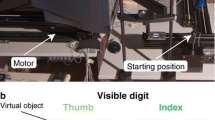Abstract
A pre-exposure, exposure, post-exposure design was used to assess the adaptation of the timing of a one-handed catch during telestereoscopic viewing. More specifically, it was examined whether the adaptation involved: (1) ignoring binocular sources of information and selecting other information, or (2) a recalibration of the coupling between the effected binocular information and the catching movement, and (3), if it is recalibration, whether it is restricted to the manipulated binocular information. To test these hypotheses, subjects (n=16) were assigned to one of two groups, each group performing three blocks of 15 trials in the dark with only the ball visible. In the exposure condition, both groups were required to catch balls under binocular telestereoscopic viewing. In the pre-exposure and post-exposure conditions, subjects performed under binocular and monocular viewing, respectively. Kinematics of the grasping movement were recorded. It was predicted that, in the case of a selection process, no afterfeffects would occur in the post-exposure condition, whereas, in the case of recalibration, aftereffects would occur. Moreover, if the recalibration is restricted to the manipulated information, only the group that was provided with binocular vision during the pre- exposure and post-exposure conditions would show aftereffects. Significant condition (pre-exposure, exposure, post-exposure) by block (first three trials, last three trials) effects were found for the moments of grasp onset, peak opening velocity and hand closure, indicating that the hand was opened and closed earlier in the first three trials of telestereoscopic viewing. This coincided with an increase in catching failures. In addition, for the moments of hand closure and peak closing velocity, negative aftereffects were found in the post-exposure condition. The hand was closed later in the first three trials after removal of telestereoscope. With respect to the presence of the aftereffects, no differences were found between the groups. It was concluded that adaptation to telestereoscopic viewing in the timing of a one-handed catch is due to the recalibration of the coupling between information and movement, rather than a selection of another source of information. Moreover, it is likely that the recalibration was not restricted to the single, manipulated information. Rather, the recalibration involves multiple binocular and monocular optical and oculomotor sources of information.
Similar content being viewed by others
Author information
Authors and Affiliations
Additional information
Received: 3 June 1998 / Accepted: 28 May 1999
Rights and permissions
About this article
Cite this article
van der Kamp, J., Bennett, S., Savelsbergh, G. et al. Timing a one-handed catch . Exp Brain Res 129, 369–377 (1999). https://doi.org/10.1007/s002210050905
Issue Date:
DOI: https://doi.org/10.1007/s002210050905




